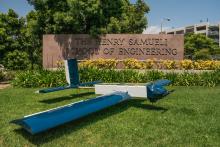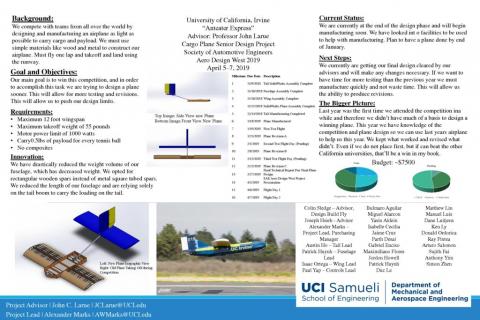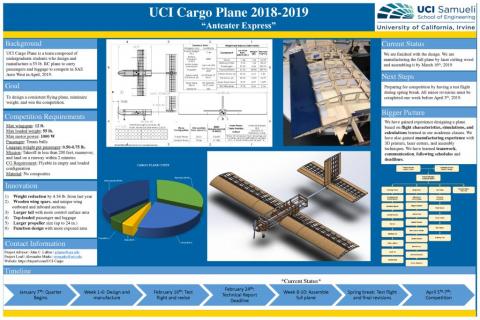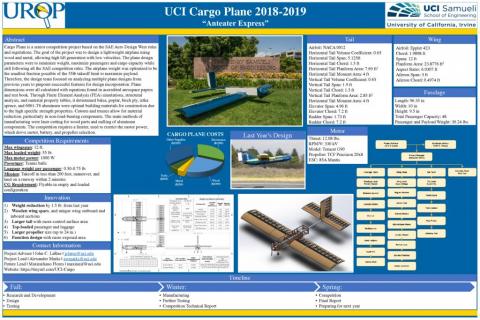Cargo Plane
Cargo Plane is a senior competition project based on the SAE Aero Design West rules and regulations. The goal of the project was to design a lightweight airplane using wood and metal, allowing high lift generation with low velocities. The plane design parameters were to minimize weight, maximize passengers and cargo capacity while still following all the SAE competition rules. The airplane weight was optimized to be the smallest fraction possible of the 55lb takeoff limit to maximize payload. Therefore, the design team focused on analyzing multiple plane designs from previous years to pinpoint successful features for design incorporation. Plane dimensions were all calculated with equations found in accredited aerospace papers and test book. Through Finite Element Analysis (FEA) simulations, structural analysis, and material property tables, it determined balsa, poplar, birch ply, Sitka spruce, and 6061-T6 aluminum were optimal building materials for construction due to the high specific strength properties. Cutouts and trusses allow for material reduction, particularly in non-load-bearing components. The main methods of manufacturing were laser cutting for wood parts and milling of aluminum components. The competition requires a limiter, used to restrict the motor power, which drove motor, battery, and propeller selection.
The “Anteater Express” is a senior design project funded by the Henry Samueli School of
Engineering of the University of California, Irvine (UCI). The project takes place during one academic
year. The project team is composed of 27 aerospace and mechanical engineering
students ranging from Sophomores to Seniors. Additionally, the team have one faculty member and one
Ph.D. student as team advisors. The team is split into four sub-team, wings, fuselage, tail, and controls.
Each section has one delegated team lead and the whole project is overseen by one project lead.
The plane is designed to minimize weight, maximize passengers and cargo capacity while still
follow all the SAE competition rules [1]. To stay well under the 55 lb weight limit, the design team
focused on analyzing multiple plane design from previous years, pinpointing successful features to
incorporate, and searching for the suitable structural materials. Plane dimensions are all calculated with
equations founded in accredited aerospace papers and testbook. Through Finite Element Analysis (FEA)
simulations, Balsa, Poplar, and Birch Ply are selected as the best building materials because they are
lightweight but strong enough to maintain the structural integrity of the plane. Sitka Spruce and 6061-T6
aluminum is selected as support materials. Cutouts and trusses are utilized to reduce material
used as well as weight, particularly in non-load-bearing components.
All wood components are fabricated using a laser cutter. The fuselage is 96.35 inches long with a
half-octagonal cross-sectional-area and an exposed tail boom. A combination of all three structural
material is used to build the fuselage. The tail boom is aluminum. The wings are fabricated from balsa
and the spars are created from Sitka spruce. The plane is powered by six servo motors, and every motor
is controlled individually through a radio signal.
The competition is hosted every year by the Society of Automotive Engineers(SAE) where we compete with teams from all over the world by designing and manufacturing an airplane as light as possible to carry cargo and payload. The competition requires teams to create a technical report, presentation, and a brochure. These combined with the flight performance generate scores for the teams where they try to have the highest possible. We must use simple materials like wood and metal to construct our airplane. The plane must fly one lap, taking off and landing using the runway. Within the airplane, we must house cargo and payload, per the competition rules. All cargo and payload must be fixed, as well as all components. We must create a presentation and brochure for the judges. We must submit a technical report by the end of February. We participate in the competition with the intent to represent the University of California, Irvine by designing and manufacturing a winning airplane.
Many students do not have knowledge about airplanes before starting the project, however by the end they have learned a multitude of things about them. This project teaches students about aircraft structures, aircraft aerodynamics, fluid dynamics, manufacturing processes, lightweight structures, material properties, and FEA analysis.
Project Advisor | Professor John C. Larue | JCLarue@UCI.edu
Project Lead | Alexander Marks | AWMarks@UCI.edu
Future Project Lead | Maximiliano Flores | Maximisf@UCI.edu




